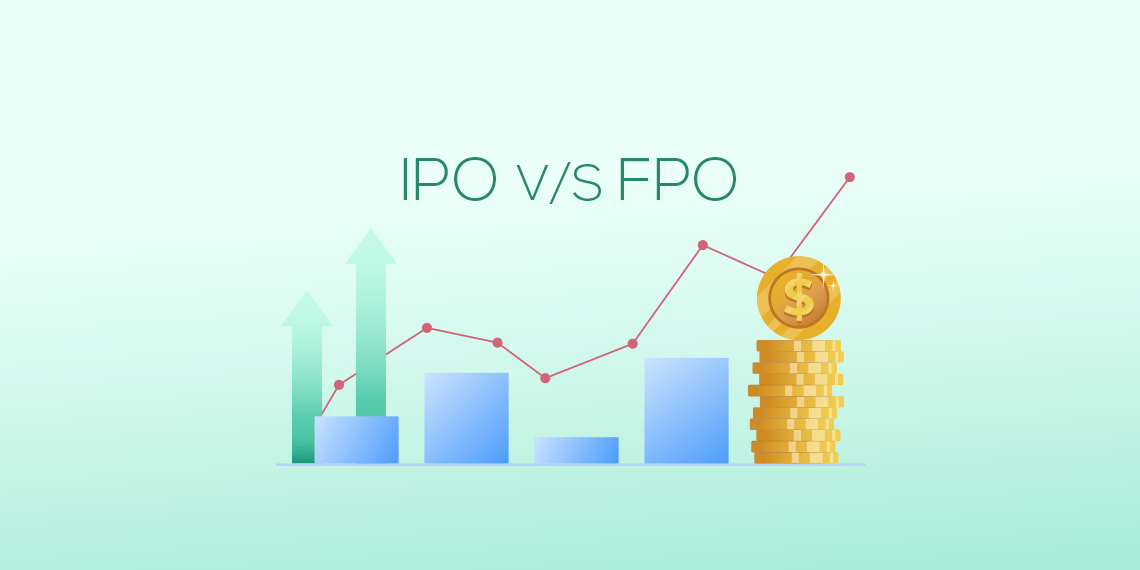Decoding IPO Vs FPO: Key Differences Unveiled

For companies looking to raise capital and expand their operations, going public through an Initial Public Offering (IPO) or a Follow-on Public Offering (FPO) can be an attractive option. Both IPO and FPO are methods by which companies raise funds by issuing shares to the public. However, they differ in several aspects. In this blog, we will explore the fundamental differences between IPO and FPO, shedding light on their unique characteristics and implications for investors and companies alike.
What is an IPO?
An IPO, or Initial Public Offering, marks the first time a privately held company offers its shares to the public for investment. It is typically done when a company seeks to raise significant capital to fuel expansion plans, repay debts, or fund research and development. During an IPO, the company issues new shares, and the funds raised go directly to the company.
What is an FPO?
An FPO, or Follow-on Public Offering, occurs when a publicly traded company decides to issue additional shares to the public. Unlike an IPO, where new shares are created, an FPO involves the sale of existing shares owned by the company's promoters, stakeholders, or major shareholders. The company itself does not receive any funds from the sale of these shares.
Purpose:
The primary purpose of an IPO is to raise capital for the company's growth and expansion plans. It provides access to a broader investor base and increases the company's visibility in the market.
On the other hand, an FPO is usually undertaken to raise additional funds for an already publicly listed company. It may be used to finance acquisitions, reduce debt, or invest in new projects.
Listing:
In an IPO, the company's shares are listed on the stock exchange for the first time. It transitions from being privately held to becoming a publicly traded entity.
In the case of an FPO, the company is already listed on the stock exchange, and the additional shares are listed for trading alongside the existing ones.
Regulatory Requirements:
The regulatory requirements for an IPO and an FPO differ. An IPO involves more rigorous scrutiny and regulatory procedures, as it involves the transition from private to public ownership. FPOs, being secondary offerings, may have a comparatively streamlined process.
Timing:
IPOs are typically launched when the company believes the market conditions are favorable for raising capital and when it is ready to embrace the increased public scrutiny that comes with being a public company.
FPOs can be conducted at any time after the company's initial listing, depending on its funding needs and market conditions.
In summary, an IPO and an FPO are both methods of raising capital through the public offering of shares. An IPO is undertaken by a company that is not yet publicly listed, seeking to raise funds for expansion and growth. On the other hand, an FPO is used by already listed companies to raise additional capital by selling existing shares to the public. Understanding the differences between these two offerings is crucial for investors and companies looking to capitalize on the opportunities they present. Whether you're considering investing in a newly listed company or looking to raise capital for your existing business, being well-informed about the distinctions between IPO and FPO will empower you to make sound financial decisions.
Frequently Asked Questions (FAQ)
1. What is an IPO?
An IPO, or Initial Public Offering, marks the first time a privately held company offers its shares to the public for investment. It is typically done to raise significant capital for expansion, debt repayment, or research and development.
2. What is an FPO?
An FPO, or Follow-on Public Offering, occurs when a publicly traded company issues additional shares to the public. Unlike an IPO, where new shares are created, an FPO involves the sale of existing shares owned by the company's promoters, stakeholders, or major shareholders.
3. What is the primary purpose of an IPO?
The primary purpose of an IPO is to raise capital for the company's growth and expansion plans. It also provides access to a broader investor base and increases the company's market visibility.
4. What is the primary purpose of an FPO?
An FPO is usually undertaken to raise additional funds for an already publicly listed company. The funds may be used to finance acquisitions, reduce debt, or invest in new projects.
5. How do IPOs and FPOs differ in terms of listing?
In an IPO, the company's shares are listed on the stock exchange for the first time, transitioning from privately held to publicly traded. In an FPO, the company is already listed on the stock exchange, and the additional shares are listed for trading alongside the existing ones.
6. What are the regulatory requirements for an IPO and an FPO?
An IPO involves more rigorous scrutiny and regulatory procedures due to the transition from private to public ownership. FPOs, being secondary offerings, may have a comparatively streamlined process.
7. When is the best time for a company to launch an IPO?
IPOs are typically launched when the company believes market conditions are favorable for raising capital and when it is ready to embrace the increased public scrutiny that comes with being a public company.
8. When can a company conduct an FPO?
FPOs can be conducted at any time after the company's initial listing, depending on its funding needs and market conditions.
9. Who receives the funds from an IPO?
In an IPO, the company issues new shares, and the funds raised go directly to the company.
10. Who receives the funds from an FPO?
In an FPO, the sale involves existing shares owned by the company's promoters, stakeholders, or major shareholders. The company itself does not receive any funds from the sale of these shares.
11. Can a company conduct multiple FPOs?
Yes, a company can conduct multiple FPOs as long as it meets the regulatory requirements and the market conditions are favorable.
12. Are there risks associated with investing in IPOs and FPOs?
Yes, both IPOs and FPOs carry risks. IPOs can be particularly volatile as the company transitions to public trading, and there is often less historical data available for evaluation. FPOs also carry risks, such as dilution of existing shares and market conditions impacting the share price.
13. How can investors make informed decisions about IPOs and FPOs?
Investors should conduct thorough research, review the company's financials, understand the purpose of the offering, and consider market conditions. Consulting with financial advisors and reading the offering prospectus can also provide valuable insights.






Member discussion